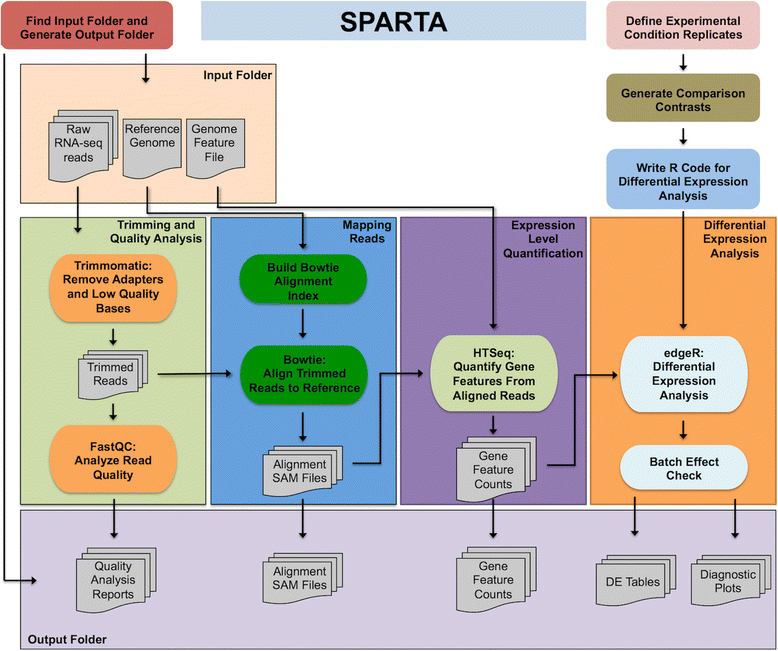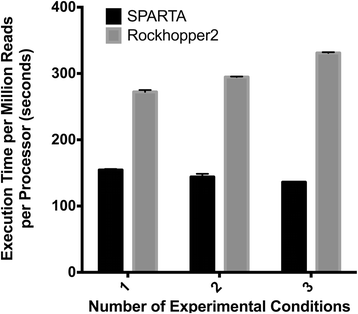SPARTA: Simple Program for Automated reference-based bacterial RNA-seq Transcriptome Analysis
- PMID: 26847232
- PMCID: PMC4743240
- DOI: 10.1186/s12859-016-0923-y
SPARTA: Simple Program for Automated reference-based bacterial RNA-seq Transcriptome Analysis
Abstract
Background: Many tools exist in the analysis of bacterial RNA sequencing (RNA-seq) transcriptional profiling experiments to identify differentially expressed genes between experimental conditions. Generally, the workflow includes quality control of reads, mapping to a reference, counting transcript abundance, and statistical tests for differentially expressed genes. In spite of the numerous tools developed for each component of an RNA-seq analysis workflow, easy-to-use bacterially oriented workflow applications to combine multiple tools and automate the process are lacking. With many tools to choose from for each step, the task of identifying a specific tool, adapting the input/output options to the specific use-case, and integrating the tools into a coherent analysis pipeline is not a trivial endeavor, particularly for microbiologists with limited bioinformatics experience.
Results: To make bacterial RNA-seq data analysis more accessible, we developed a Simple Program for Automated reference-based bacterial RNA-seq Transcriptome Analysis (SPARTA). SPARTA is a reference-based bacterial RNA-seq analysis workflow application for single-end Illumina reads. SPARTA is turnkey software that simplifies the process of analyzing RNA-seq data sets, making bacterial RNA-seq analysis a routine process that can be undertaken on a personal computer or in the classroom. The easy-to-install, complete workflow processes whole transcriptome shotgun sequencing data files by trimming reads and removing adapters, mapping reads to a reference, counting gene features, calculating differential gene expression, and, importantly, checking for potential batch effects within the data set. SPARTA outputs quality analysis reports, gene feature counts and differential gene expression tables and scatterplots.
Conclusions: SPARTA provides an easy-to-use bacterial RNA-seq transcriptional profiling workflow to identify differentially expressed genes between experimental conditions. This software will enable microbiologists with limited bioinformatics experience to analyze their data and integrate next generation sequencing (NGS) technologies into the classroom. The SPARTA software and tutorial are available at sparta.readthedocs.org.
Figures


Similar articles
-
QuickRNASeq lifts large-scale RNA-seq data analyses to the next level of automation and interactive visualization.BMC Genomics. 2016 Jan 8;17:39. doi: 10.1186/s12864-015-2356-9. BMC Genomics. 2016. PMID: 26747388 Free PMC article.
-
UTAP: User-friendly Transcriptome Analysis Pipeline.BMC Bioinformatics. 2019 Mar 25;20(1):154. doi: 10.1186/s12859-019-2728-2. BMC Bioinformatics. 2019. PMID: 30909881 Free PMC article.
-
A Guide for Designing and Analyzing RNA-Seq Data.Methods Mol Biol. 2018;1783:35-80. doi: 10.1007/978-1-4939-7834-2_3. Methods Mol Biol. 2018. PMID: 29767357
-
Differential Expression Analysis of RNA-seq Reads: Overview, Taxonomy, and Tools.IEEE/ACM Trans Comput Biol Bioinform. 2020 Mar-Apr;17(2):566-586. doi: 10.1109/TCBB.2018.2873010. Epub 2018 Oct 1. IEEE/ACM Trans Comput Biol Bioinform. 2020. PMID: 30281477 Review.
-
Characterizing and annotating the genome using RNA-seq data.Sci China Life Sci. 2017 Feb;60(2):116-125. doi: 10.1007/s11427-015-0349-4. Epub 2016 Jun 13. Sci China Life Sci. 2017. PMID: 27294835 Review.
Cited by
-
Transcriptomic analysis of Myxococcus xanthus csgA, fruA, and mrpC mutants reveals extensive and diverse roles of key regulators in the multicellular developmental process.BMC Genomics. 2025 Apr 8;26(1):355. doi: 10.1186/s12864-025-11417-z. BMC Genomics. 2025. PMID: 40200151 Free PMC article.
-
Adaptive responses of Trichlorobacter lovleyi to nitrite detoxification reveal overlooked contributions of Geobacterales to nitrate ammonification.ISME J. 2025 Jan 2;19(1):wraf054. doi: 10.1093/ismejo/wraf054. ISME J. 2025. PMID: 40101204 Free PMC article.
-
Comparative Analysis of Strategies for De Novo Transcriptome Assembly in Prokaryotes: Streptomyces clavuligerus as a Case Study.High Throughput. 2019 Nov 30;8(4):20. doi: 10.3390/ht8040020. High Throughput. 2019. PMID: 31801255 Free PMC article.
-
PrrA modulates Mycobacterium tuberculosis response to multiple environmental cues and is critically regulated by serine/threonine protein kinases.PLoS Genet. 2022 Aug 1;18(8):e1010331. doi: 10.1371/journal.pgen.1010331. eCollection 2022 Aug. PLoS Genet. 2022. PMID: 35913986 Free PMC article.
-
2-aminoimidazoles potentiate ß-lactam antimicrobial activity against Mycobacterium tuberculosis by reducing ß-lactamase secretion and increasing cell envelope permeability.PLoS One. 2017 Jul 27;12(7):e0180925. doi: 10.1371/journal.pone.0180925. eCollection 2017. PLoS One. 2017. PMID: 28749949 Free PMC article.
References
Publication types
MeSH terms
Substances
Grants and funding
LinkOut - more resources
Full Text Sources
Other Literature Sources
Molecular Biology Databases

